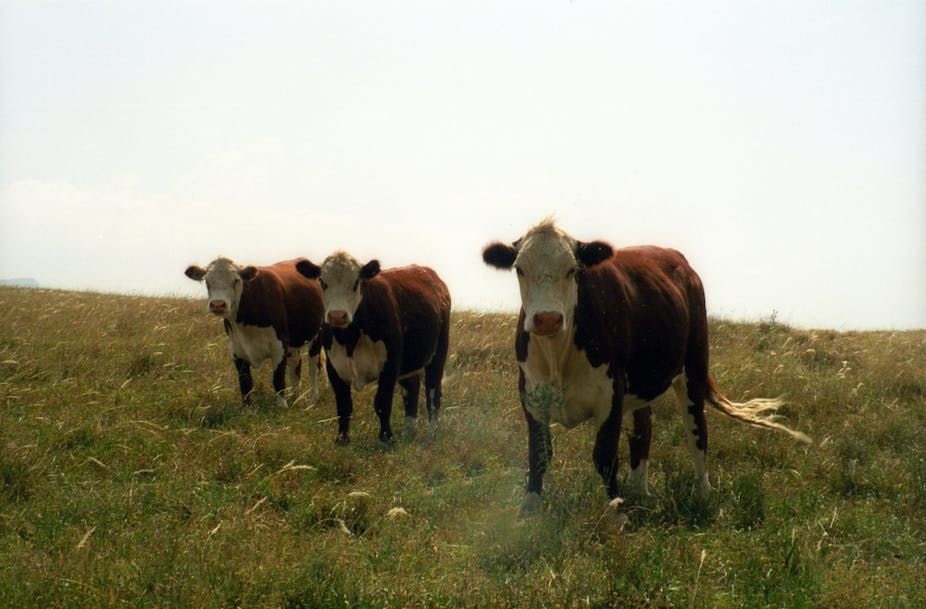In Enid Blyton’s Magic Faraway Tree, Jo, one of the child adventurers, has a spell cast upon him that forces him to walk upside down on his hands in Topsy Turvy land. Jo survives the ordeal as most humans would. But in the less than magic faraway land of Egypt, recent footage of Australian cattle being turned upside down before slaughter is far more concerning.
This latest distressing footage from Animals Australia of cruelty to cattle being slaughtered in Egypt has confirmed that abattoir exposures are here to stay, or at least as long as Australia continues to export live cattle to far distant developing countries.
On this occasion, cattle are shown being inverted 180 degrees before the lethal cut to their throat, the knife cut that all cattle must die from in Egyptian abattoirs. The argument in favour of this cruel practice is that the knife cut is easier and safer in a downward motion, rather than an upward cut to a standing animal.
In cattle the position of the internal organs, in particular the rumen, means that inversion will result in severe distress. Unlike horses, they cannot even lie on their sides for any period of time. The respiratory system is the most affected, with potential inhalation of digesta and blood. Even if we do not yet fully understand its implications for the animals, the impact of the evident fear that inversion causes cannot be ignored.
Additional problems include inadequate restraint, pressure on internal organs and prolongation of the already stressful slaughter process. One of the animals in the Animals Australia footage escapes and takes an agonising 90 seconds to be eventually apprehended, despite its head hanging off following the knife cut.
The difference between Egyptian cattle, that are led to the fields and back daily, and the Australian cattle, which are only handled a few times a year, cannot be underestimated. Egyptian slaughtermen are well aware that the Australian cattle react in a nervous and unpredictable manner to their movements.
If the job actually is easier with the animal inverted – and there is no evidence that it is – this is an argument for better training of the slaughterman and sharper knives, not inversion. Stunning would obviate any of the above concerns, and is not contrary to Koranic teaching if used concurrently with the knife cut or just after.
If all of this doesn’t seem like déjà vu, cast your mind back to the ban on cattle export to Egypt in 2006. Then, the Egyptian slaughtermen were found to be cutting the tendons of the legs of Australian cattle prior to slaughter, because the cattle were able to be slaughtered more safely after being incapacitated in this way.
Although illegal in the UK and Denmark, livestock inversion for slaughter remains legal in the European Union and is not condemned by the World Animal Health Organisation (OIE), the only body to set international guidelines for livestock slaughter.
The Australian government has not been able to develop an Exporter Supply Chain Assurance Scheme (ESCAS) agreement with Egypt, such as has been implemented in some Asian countries. Through ESCAS, the Australian government hopes to ensure that animals are handled in accordance with OIE guidelines, that they are traceable through the supply chain and that independent audits are conducted to verify compliance.
Although this scheme has clear benefits, its legality is questionable; and indeed the scheme has been rejected by Saudi Arabia, at least. One of the principal objections is on the grounds of fair trade: under WTO agreement, participating countries cannot introduce a trade barrier on animal welfare grounds. Any requirement by ESCAS that animals are only allowed to enter the country if OIE animal welfare guidelines are followed is just such an act of discrimination.
However, the main issue is much simpler than this, and in any case the WTO control of trade is often flouted. It is the poor economic status of Egyptian workers, and in particular abattoir workers, which does not afford them the level of concern for their animals that we have in the Western world.
Western abattoir workers are given the luxury of protection from the violent protestation of the animals during the slaughter process by stunning them beforehand, as well as enclosing the animal in a safe crush during the process and having an orderly line of cattle to kill.
This Australian government renewed ban on export of cattle to Egypt will cost the industry dearly. The collapse of the Egyptian market in 2003-2004, before the Indonesian trade grew rapidly, was highly damaging to the trade and left producers with an uncertain market.

The Indonesian trade is still badly affected by the 2011 ban, with the country vowing to build up its own industry rather than accept large numbers of cattle from Australia. Only major shortages in the Indonesian markets have brought a temporary reprieve. Prices in Egypt are traditionally higher than many other countries; hence the financial impact will be even greater than expected.
These short-term bans are becoming a feature of Australian government response to video releases by activist groups. The time for government-approved resumption of the trade appears to be about 12-18 months, but quite likely depends on the financial impact to the producers and the vehemence of their reactions.
The solution, which is so clearly in the best interest of Australia’s livestock producers, is a long-term ban, phased in over a period of five years. This would give the trade the time to adapt: build new meatworks in the north of the country, open up new markets to developed countries wanting our high quality product and develop the supply chains internationally. The alternative is the death by a thousand cuts, hopefully in the supine position.
Throughout history humans have reserved upside down crucifixion and burial for people that are not worthy; let’s at least give cattle the dignity of a respectful end to their life.

